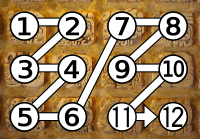|
Aztec Pictograms
The Aztec or Nahuatl script is a pre-Columbian writing system that combines ideographic writing with Nahuatl specific phonetic logograms and syllabic signs which was used in central Mexico by the Nahua people. Origin The Aztec writing system derives from writing systems used in Central Mexico, such as Zapotec script. Mixtec writing is also thought to descend from Zapotec. The first Oaxacan inscriptions are thought to encode Zapotec, partially because of numerical suffixes characteristic of the Zapotec languages. Structure and use Aztec was pictographic and ideographic proto-writing, augmented by phonetic rebuses. It also contained syllabic signs and logograms. There was no alphabet, but puns also contributed to recording sounds of the Aztec language. While some scholars have understood the system not to be considered a complete writing system, this is disputed by others. The existence of logograms and syllabic signs is being documented and a phonetic aspect of the writing sys ... [...More Info...] [...Related Items...] OR: [Wikipedia] [Google] [Baidu] |
Nahuatl Language
Nahuatl (; ), Aztec, or Mexicano is a language or, by some definitions, a group of languages of the Uto-Aztecan languages, Uto-Aztecan language family. Varieties of Nahuatl are spoken by about Nahuas, Nahua peoples, most of whom live mainly in Central Mexico and have smaller populations Nahuatl language in the United States, in the United States. Nahuatl has been spoken in central Mexico since at least the seventh century CE. It was the language of the Aztecs, Aztec/Mexica, who dominated what is now central Mexico during the Late Postclassic period of Mesoamerican chronology, Mesoamerican history. During the centuries preceding the Spanish conquest of the Aztec Empire, Spanish and Tlaxcalan conquest of the Aztec Empire, the Aztecs had expanded to incorporate a large part of central Mexico. Their influence caused the variety of Nahuatl spoken by the residents of Tenochtitlan to become a prestige dialect, prestige language in Mesoamerica. After the conquest, when Spanish colonist ... [...More Info...] [...Related Items...] OR: [Wikipedia] [Google] [Baidu] |
Maya Hieroglyphs
Maya script, also known as Maya glyphs, is historically the native writing system of the Maya civilization of Mesoamerica and is the only Mesoamerican writing system that has been substantially deciphered. The earliest inscriptions found which are identifiably Maya date to the 3rd century BCE in San Bartolo, Guatemala. Maya writing was in continuous use throughout Mesoamerica until the Spanish conquest of the Maya in the 16th and 17th centuries. Maya writing used logograms complemented with a set of syllabic glyphs, somewhat similar in function to modern Japanese writing. Maya writing was called "hieroglyphics" or hieroglyphs by early European explorers of the 18th and 19th centuries who found its general appearance reminiscent of Egyptian hieroglyphs, although the two systems are unrelated. Though modern Mayan languages are almost entirely written using the Latin alphabet rather than Maya script, there have been recent developments encouraging a revival of the Maya glyph sys ... [...More Info...] [...Related Items...] OR: [Wikipedia] [Google] [Baidu] |
Aztec
The Aztecs () were a Mesoamerican culture that flourished in central Mexico in the post-classic period from 1300 to 1521. The Aztec people included different Indigenous peoples of Mexico, ethnic groups of central Mexico, particularly those groups who spoke the Nahuatl, Nahuatl language and who dominated large parts of Mesoamerica from the 14th to the 16th centuries. Aztec culture was organized into city-states (''altepetl''), some of which joined to form alliances, political confederations, or empires. The Aztec Empire was a confederation of three city-states established in 1427: Tenochtitlan, city-state of the Mexica or Tenochca; Texcoco (altepetl), Texcoco; and Tlacopan, previously part of the Tepanec empire, whose dominant power was Azcapotzalco (altepetl), Azcapotzalco. Although the term Aztecs is often narrowly restricted to the Mexica of Tenochtitlan, it is also broadly used to refer to Nahuas, Nahua polities or peoples of central Pre-Columbian Mexico, Mexico in the preh ... [...More Info...] [...Related Items...] OR: [Wikipedia] [Google] [Baidu] |
Mesoamerican Writing Systems
Mesoamerica, along with Mesopotamia and China, is one of three known places in the world where writing is thought to have developed independently. Mesoamerican scripts deciphered to date are a combination of logographic and syllabic systems. They are often called hieroglyphs due to the iconic shapes of many of the glyphs, a pattern superficially similar to Egyptian hieroglyphs. Fifteen distinct writing systems have been identified in pre-Columbian Mesoamerica, many from a single inscription. The limits of archaeological dating methods make it difficult to establish which was the earliest and hence the forebear from which the others developed. The best documented and deciphered Mesoamerican writing system, and the most widely known, is the classic Maya script. Earlier scripts with poorer and varying levels of decipherment include the Olmec hieroglyphs, the Zapotec script, and the Isthmian script, all of which date back to the 1st millennium BC. An extensive Mesoamerican literature ... [...More Info...] [...Related Items...] OR: [Wikipedia] [Google] [Baidu] |
Phoenix Books
Orion Publishing Group Ltd. is a UK-based book publisher. It was founded in 1991 and acquired Weidenfeld & Nicolson the following year. The group has published numerous bestselling books by notable authors including Ian Rankin, Michael Connelly, Nemir Kirdar and Quentin Tarantino. History Orion Books was launched in 1992, with Orion purchasing the assets of Chapman publishers the following year. In the same year (1993), Orion acquired a warehousing and distribution centre called Littlehampton Book Services (LBS), which was based in Sussex in the UK. A majority share capital of Orion was sold to Hachette Livre in 1998, before Hachette Livre became the sole owner of the Orion Publishing Group in 2003. In December 1998, Orion acquired publishing house Cassell, whose imprints included Victor Gollancz Ltd. This imprint became a part of the Orion group and Orion also took ownership of the Cassell Military list. After acquiring Hodder Headline, Hachette UK was formed, with Orion as its ... [...More Info...] [...Related Items...] OR: [Wikipedia] [Google] [Baidu] |



